Rental Cars and Ryokans
Last week, Sachi and I headed to Saku, Sachi’s hometown. This time we decided to go the rental car route, seeing it as much more convenient than train and having relatives cart us around. The costs were close–The rental car, including all insurance and extras, was about ¥23,000 for a 3-day rental, while the train fare would have been ¥26,000. Add gas and tolls, and the rental car total went up to about ¥35,000–but add the convenience of going where we wanted, when we wanted (runs to the store for eats, and even a Costco run added to the end of the trip), and especially not requiring Sachi’s family to act as our chauffeurs for the 3-day period, and I call it a worthwhile expense.
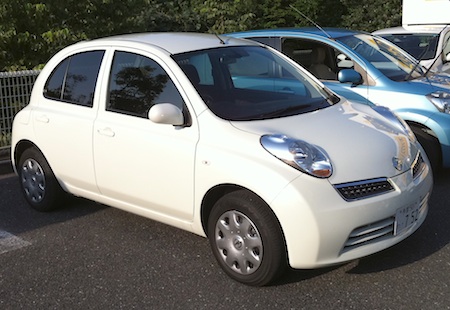
The rental car business annoyed me some. Not the main process–it’s pretty painless, just fill in the usual name & address thing, and you’re in the car. But the last-minute added charges for you-have-no-idea-what-this-is-but-you-can’t-risk-not-getting-it kind of stuff. They carefully don’t mention it until you are ready to walk out the door, and are undoubtedly up against a schedule, like I was, and had no time to run through all the minutiae. (I had visited days earlier to make the reservation, and had even asked about the price, and they didn’t bring it up.) They say it’s insurance and other serious-sounding and maybe even legally-required kind of stuff, and it’s certainly made to look like you need it, but–even if you spoke the language well enough–I’m pretty sure many other novices would also have been intimidated, like I was, into paying for it all. I am fairly certain that most of it was not needed, but I had no way to tell, and no time to sort through it, especially as I’m certain it would have involved all kinds of technical language. I blame myself–I have rented cars before, I just forgot about this. It’s more than the kind of thing travel agents do, hiding the taxes and so forth until you’ve more or less committed–this is more of a real con game. And I felt like a first-class sucker. Good lesson.
Anyway.
The drive was pleasant enough, though we got into trouble because of the GPS. This is a usual thing, getting a rental vehicle with a complicated gadget which even for regular users can be a pain to figure out. I kept on giving it the destination, and it kept on insisting we take local roads. Again, I felt stupid–I really should have researched the route ahead of time. The thing was, when we first set the route, it looked OK, and seemed to match what Google Maps said we’d be doing–going past the expressway to circle around and find an entrance, or “interchange” for the expressway (since Japanese expressways are all toll roads, they don’t have exits as often as U.S. freeways do). But after we passed a rather clear route to get on the expressway and the Nav System kept insisting we keep going on route 254, a narrow and crowded avenue with slow traffic, it was clear that it was leading us the wrong way. Driving half-blindly, I took the route that seemed best to me, and got on the expressway. Then we got the usual nonsense with the Nav System insisting we leave the expressway at every new exit and take normal roads. But we did have fun telling the Nav System to bugger off whenever it did so.
We stopped at a rest station along the way to get some grub and I took the time to figure out the right way to program the device. It turns out that when you program the destination into the system, it seems ready at one point, but there was a button rather misleadingly labeled, down a list that was topped by a “calculate route” button, but the lesser button led you to a menu which allowed you to specify toll roads, turned off by default–seems rather dumb with rental cars so often used for long-distance driving like we were.
Then we got to the ryokan:
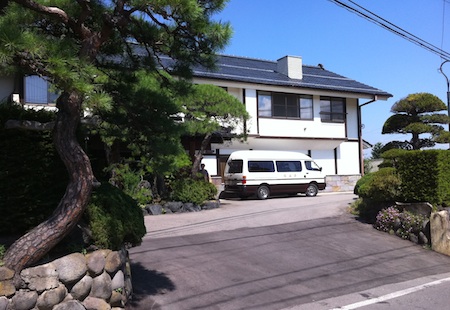
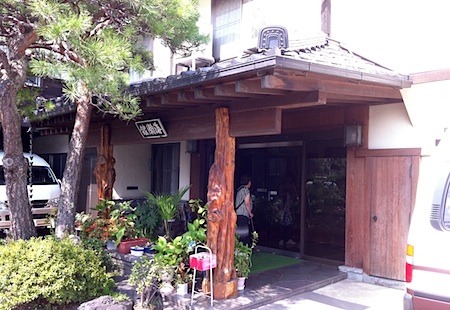
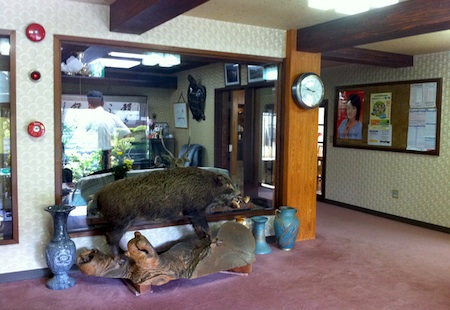
While in Saku, we usually stay at a ryokan, a countryside inn. This is an experience you have to have if you visit Japan. These are buildings that have a very traditional look and feel–definitely not the business-hotel variety of lodging. The ryokan is usually surrounded by manicured gardens, has an almost hunting-lodge-meets-classic-Japanese-decor lobby, an obligatory inner garden, and rooms decked out with tatami, tokonoma, sliding doors, shoji doors for the windows, floor chairs and mats, low-set wood tables, and of course futons. Cut out in the corner of the image below are the slightly out-of-place Hi-def TV and the air conditioner.
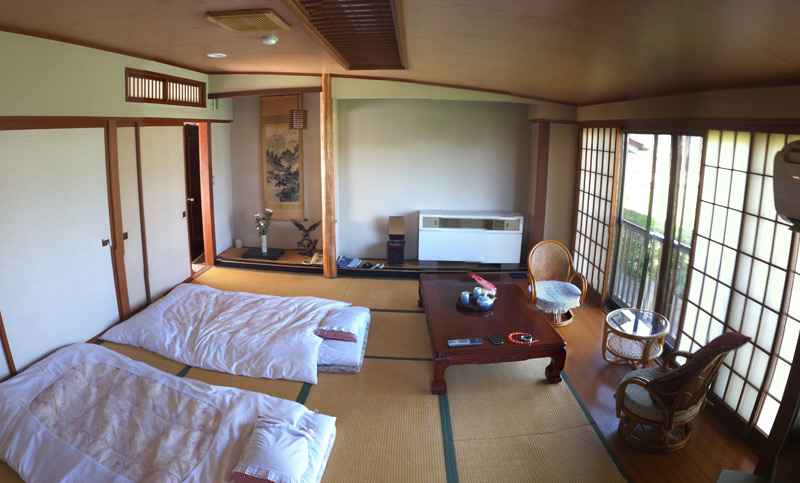
Alas, I forgot to get photos of the most ryokan-ish part of the stay, dinner. Ryokan dinners are a cacophony of more than a dozen separate dishes, including miso soup, pickled vegetables, sashimi, grilled fish, vegetable dishes, shellfish, shaved beef cooked on rounded frying plates, eel on a bed of rice, and other bits and pieces. The fish is iconic, basically a small fish (maybe 6-8 inches) skewered on a stick, covered with salt, grilled whole, head and fins and tail and all. I am infamous with Sachi for not liking most of what these dinners offer up, and since it’s important to Sachi that we eat together, it’s a sticking point against staying in places like these, even though they can be central, even essential, on trips like this. Sachi and her mother, fortunately, claimed that they really weren’t in the mood for the beef or sashimi or many of the veggies–all things which I liked–and claimed to be hungry for the stuff I didn’t like. What a coincidence! They protested that really, they weren’t just doing this for me, but I wasn’t fooled.
Breakfasts aren’t much different–mussel soup, a hunk of dry cold, fishy-tasting cooked salmon, salad–you know, normal breakfast fare. Fortunately I can get by without breakfast.
A nice point about ryokans are the baths. This one, however, was a tad more exposed than I prefer. The ladies’ bath is downstairs and out of view, but the men’s bath is upstairs. You walk in to the dressing room, undress, and walk into the bath. Now, the inn is situated on a river in the midst of a small town. And the men’s bath has floor-to-ceiling clear glass windows. Here’s what it looks like when you walk in:
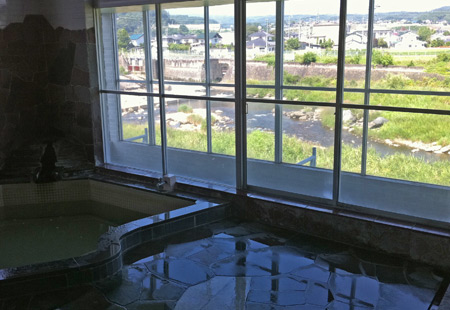
Pretty big windows. You look out, and realize that you are standing, buck naked, in direct view of, well, the neighborhood.
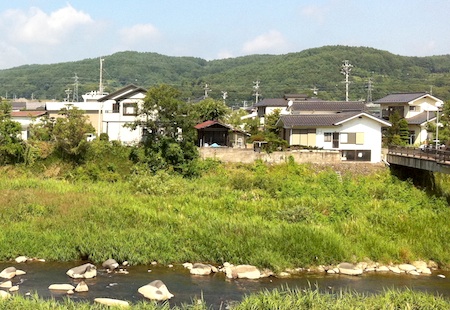
Charming.
Sachi later pointed out that since we were the only ones staying there that day, I could have used the ladies’ bath with her. She mentions this after I finished my bath. Swell.

Trivia: Saku is just about as remote from the ocean as you can get in Japan (maybe if you go further SW into Nagano-ken you’ll be further from the Japan Sea, but it’s close!).
For being “adjacent” to Tokyo it sure is far — 100 hard miles.
My favorite memories of Japan are certainly the ryokan I stayed at. Such a civilized mode compared to the daily grind.
Did I say ‘adjacent to Tokyo’? If so, then sorry–Tokyo and Nagano are definitely separate, especially as the car drives. We had to go through Saitama and Gunma on our route. I think that Saitama and Yamanashi get between Nagano and Tokyo directly. And yeah, from door to door it was exactly 100 miles–but in the end, we wound up traveling a lot more than that, of course.
Oops I meant adjacent to the Kanto area. . .
I would like to know what is the average price of Ryokan outside of Tokyo. Is the one you stayed a typical ryokan or more on the expensive side? I was curious to know the cost of ryokan’s today.
Appreciate your feedback.
Thanks.
Francesco:
The prices of ryokans vary widely. The one we stayed at was quite inexpensive. Stay-only per person is 4,500 yen; with breakfast only, 5,000 yen; and with breakfast and dinner, 8,000 yen per day.
I am sure that you can find prices going from there to super-luxury rates. Outside of this one place, we don’t actually stay at ryokans too much, but usually opt for small inns with European-style chefs.